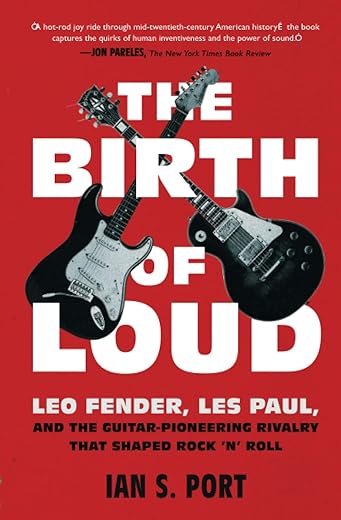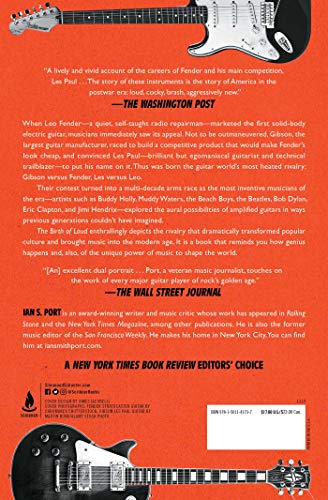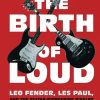The Birth of Loud: Leo Fender, Les Paul, and the Guitar-Pioneering Rivalry That Shaped Rock ‘n’ Roll
£12.30£15.20 (-19%)
In the years after World War II, music was evolving from big-band jazz into rock ’n’ roll—and these louder styles demanded revolutionary instruments. When Leo Fender’s tiny firm marketed the first solid-body electric guitar, the Esquire, musicians immediately saw its appeal. Not to be out-maneuvered, Gibson, the largest guitar manufacturer, raced to build a competitive product. The company designed an “axe” that would make Fender’s Esquire look cheap and convinced Les Paul—whose endorsement Leo Fender had sought—to put his name on it. Thus was born the guitar world’s most heated rivalry: Gibson versus Fender, Les versus Leo.
While Fender was a quiet, half-blind, self-taught radio repairman, Paul was a brilliant but headstrong pop star and guitarist who spent years toying with new musical technologies. Their contest turned into an arms race as the most inventive musicians of the 1950s and 1960s—including bluesman Muddy Waters, rocker Buddy Holly, the Beatles, Bob Dylan, and Eric Clapton—adopted one maker’s guitar or another. By 1969 it was clear that these new electric instruments had launched music into a radical new age, empowering artists with a vibrancy and volume never before attainable.
In “an excellent dual portrait” (The Wall Street Journal), Ian S. Port tells the full story in The Birth of Loud, offering “spot-on human characterizations, and erotic paeans to the bodies of guitars” (The Atlantic). “The story of these instruments is the story of America in the postwar era: loud, cocky, brash, aggressively new” (The Washington Post).
Read more
Additional information
| Publisher | Scribner (19 Nov. 2019) |
|---|---|
| Language | English |
| Paperback | 360 pages |
| ISBN-10 | 1501141732 |
| ISBN-13 | 978-1501141737 |
| Dimensions | 13.97 x 2.29 x 21.27 cm |











by Bassman
I bought this book on the strength of the reviews and the fact that I am one of the frequently mentioned ‘guitar nerds’. I would say that this book would definitely not satisfy, in any way, the ‘guitar nerd’. All of the information about Leo Fender and the development of the Tele, Strat, Precision and his amps is very well known and is related here in so minimal detail that it would have required little or no research. In fact the development of the Tele, the Strat and the Precision is skimmed over in almost ‘zero detail’ and in view of the fact that the book goes up to the mid to late sixties there’s virtually no mention of the Jazz bass. The book is written in a largish type face, has lots of very short chapters and a lot of white space. I don’t buy books ‘by the yard’ but it took me less than a day to read this book and I learnt precisely nothing that I didn’t know before. If you are interested in Leo Fender and the guitars, basses and amps he designed and the history of the company he founded than you need look no further than the thoroughly excellent ‘Fender – The Golden Age – 1946 to 1970’ by Martin and Paul Kelly and Terry Foster. A superb book. Also, the book has lots of ‘loose ends’ with some ‘anecdotes’ left in ‘mid-air’ as if the author has ‘lost his thread’. The book appears to also be poorly ‘proof read’ and there are many inaccuracies – like how Leo lost his eye (the author states that he had an accident and fell – in fact he lost his eye to a cancerous tumour at the age of eight). There’s also too much about individuals who, whilst interesting musicians in themselves, had no bearing at all on the development of solid body guitars nor their ‘popularisation’ – they just played them. Carol Kaye and James Jamerson for instance were great bass players but the Precision had been around for well over a decade before they picked it up and had already sold thousands and was well established at the ‘go to’ bass for most pro players. Ditto (the wildly over-rated) Jimi Hendrix and the Strat. Also, given the type of person that would probably be buying this book, do we really need to be told that the bridge is where the strings join the body of the guitar (not strictly true actually – especially in the case of the Gibson) or that the headstock is where the strings attach to the tuners? Fender’s ‘offset body’ series of guitars are also referred to as ‘blob-like’ – what’s that meant to mean? As for Les Paul, I’m not sure why he’s here at all – because of the premise of the book I guess – to make it into a ‘battle’ rather than just a ‘boring’ history. He, like millions of others tinkered with his amps but developed nothing at all, he experimented with multi-track recording to good effect but that’s got nothing to do with guitar development but he did, I admit. create his infamous ‘log’ guitar but it was crude and went ‘nowhere’ and a few others were doing the same thing at the same time anyway and he had no input whatsoever into the design of the Gibson Les Paul guitar – apart from putting his name on the headstock in return for a 5% royalty – I reckon Gibson were ‘done’ if you ask me. Also, there is no real story to be told behind the Les Paul guitar itself – it was just a ‘me too’ answer to the Tele but built in a traditional Gibson style – set neck, carved top etc. Anyway, if you’re going to write a book like this then you should do it properly and tell the story thoroughly, preferably in chronological order and with an understanding of the guitars, basses and amps that you are documenting. Ian Port hasn’t. Personally, I don’t think he is a guitar or bass player – I may be wrong but he comes across as just another music journalist trying his hand at a full length book. This is a book for people who aren’t really guitar ‘enthusiasts’ or players, who aren’t much bothered about Leo Fender’s (VERY considerable) contributions and don’t want to be bothered with too much detail and in any case aren’t particularly fussy whether the detail that is actually there is accurate or not. Two stars is rather generous. Leo would turn in his grave. Leo Fender vs Les Paul? Give me a break! A bit like Real Madrid vs Rotherham United!
by Mister Hex
I bought this for my dad, who taught me to play guitar a million years ago or so, and from what he’s told me he hasn’t been able to put this down. I’m told it’s well written and very informative. My dad has taste.
by Gonch888
A fascinating story . Read why the instruments they designed are still the most desired to this day, and of some of the most famous players.
by Peter Metcalfe
A great insight into the birth of the electric guitar and the inevitable rivalry between Leo, Les, Paul Bigsby. I thoroughly recommend it to anyone i terested in this subject.
by mrssusanburns
It was a present for my son who is in the music business. He absolutely enjoyed reading it and said it was a fantastic book.
by Doug W
A fascinating read for anyone into their electric guitars, really enjoyed this one
by Nick Beadle
Well researched but ultimately a book that overflows with passion for the subject. Mainly focused on American musicians, although Brits do get a mention. Only omission I could see was the lack of mention of Hank Marvin in relation to the Fender Strat…. Thoroughly enjoyable book for anyone who loves music and the electric guitar.
by Timothy Jones
As a guitar player with a keen interest in the myriad roles the electric guitar plays in modern music this book filled in the history, the rivalry and the personalities behind the development of the electric guitar, namely the Fender Telecaster and Stratocaster and Precision Bass alongside the Gibson Les Paul. It introduces the importance of Paul Bigsby (he of the original tremolo arm aka the whammy bar) a keen motorcyclist.
If you love guitars this book is for you!